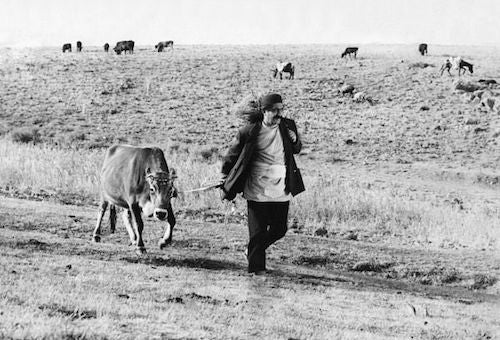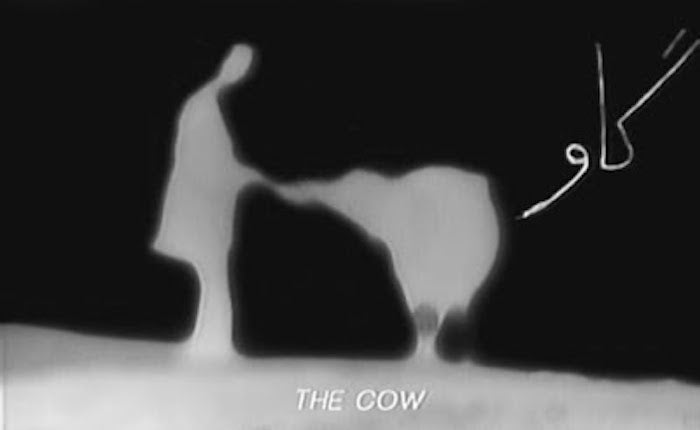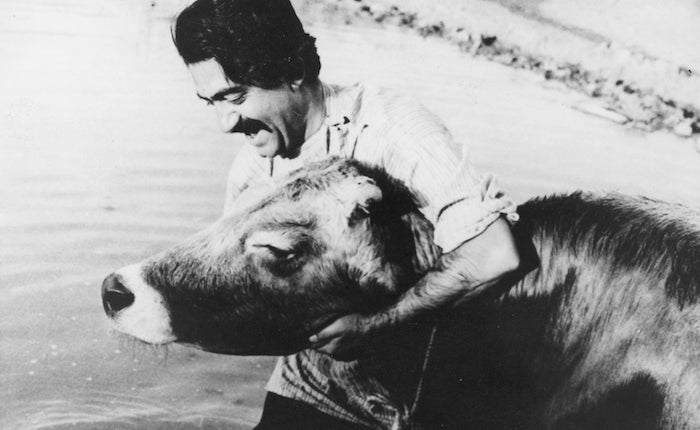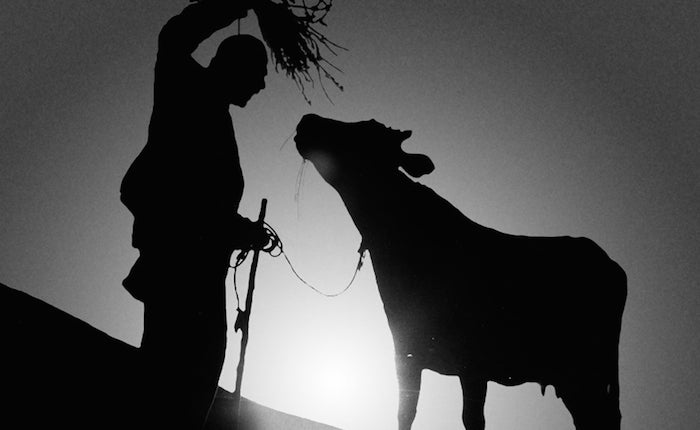
The Cow (1969)
On May 13 as part of the UCLA Celebration of Iranian Cinema, professor Hamid Naficy from Northwestern University introduced Dariush Mehrjui’s 1969 film The Cow, and signed copies of his massive, four-volume book, A Social History of Iranian Cinema (Duke University Press, 2011-12). We were honored to have Hamid at the screening, because in 1990 he was the progenitor of the Iranian film festival and he earned his Ph.D. at UCLA. Furthermore, Hamid and I have long shared a research interest in Exile Studies, he from the Iranian and Third World perspective, mine dedicated to the German-Jewish exiles from Hitler. I had heard about The Cow as an important precursor to Iran’s post-revolutionary cinema of Abbas Kiarostami et al, but was unprepared for seeing an original masterpiece.
The film announces its high art intentions in the credits sequence with a completely out of focus, black and white negative image of what appears to be a man and a cow moving towards the camera. The two abstracted figures keep melding together, then separating, foreshadowing what will be the drama’s central narrative conceit. The film concerns a dirt poor farmer in the arid hinterlands of Persia, who loves and dotes over his cow. She is the apple of Hassan’s eye, accompanying her out to pasture daily to graze on grass, seemingly closer to his heart than his wife. When he feeds her fresh cut clover, he nozzles her and pretends to chew with her. The cow is also pregnant, so that the farmer takes on the role of the soon-be-become father, since he and his wife have no visible children.

The Cow (1969)
Everyone in the tiny village partakes in his happiness, because they have even less than he does, and no one else has a cow. Indeed, it is unclear how the villagers live at all, given we see no other commercial or agricultural activity, no vehicles, except for a single donkey cart; we see no vegetation or gardens, only barren, clay and stone structures. There are virtually no interiors, except the stall of the bovine. All village life seemingly takes place around a pond with numerous spectators only seen in windows. It is there that the village idiot is merciless and repeatedly harassed by roving street urchins, that preparations are made for the wedding of a young couple, and where villagers gather to deal with the film’s major crisis.
When Hassan takes a short trip to the capital, the cow suddenly dies. The villagers debate what is to be done, worried that the well-liked farmer will not survive the bad news; so they bury the cow in the old village well and plan to tell Hassan that his cow has wandered off and can’t be found. Hassan, upon his return, refuses to believe that his cow has abandoned him and slowly takes on the cow’s personality, living in the stall and eating only grass. Realizing that the farmer has descended into madness, Eslam and other villagers are forced to tie him up and drag him to the nearest hospital, against his will, beating him like an animal to get him to move forward. The man/cow eventually breaks free in a rainstorm and falls to his death.

The Cow (1969)
A UCLA film student and philosophy graduate, Dariush Mehrjui directed his first feature in 1966 in Teheran, a commercial spy movie, before producing The Cow with funding from the Shah of Iran. Upon completion, the film was immediately banned in Iran for its negative portrayal of the impoverished Iranian countryside – Hamid Naficy mentioned in his introduction that Mehrjui was forced to whitewash the village before shooting, so it didn’t look quite as decrepit. The film was smuggled out of Iran and won the FIPRESCI critics prize at the Venice Film Festival in 1971, as well as a subsequent prize in Berlin, before finally being screened in Iran. Mehrjui, of course, went on to make many other important films before and after the revolution, including The Cycle (1978), Hamoun (1990) and Santouri (2007).
With The Cow, Mehrjui creates a unique blend of realism and absurdist folktale. Influenced by Italian neorealism and his teacher at UCLA, Jean Renoir, the director coaxes incredibly nuanced and realistic portrayals from his actors, especially Ezzatolah Entezami, who deservedly won an acting prize at the Chicago Film Festival for his amazing performance; his face and body literally begin to look like his cow after he takes on the animal’s persona. The cast of professional stage actors, all of whom got their first film experience with The Cow, also communicate the anguish and perplexed looks of villagers confronted with a phenomenon they do not understand. Mehrjui’s stunning, yet sparse cinematography consistently frames individual villagers and groups in tight closeups or through windows, doors, and above walls, limiting our vision, and that of the villagers to move around in space; it is an unchanging world that suddenly appears to fall out of its anchor when the cow dies. But mysteries remain: three shadowy figures from another village may have killed the cow, appearing periodically in the village and on a distant hillside. Hassan’s metamorphosis, like that of Kafka’s clerk, remains unknowable, as do the quasi-religious rituals performed by an old woman.

The Cow (1969)
This is a deeply moving film about what it means to be human. Some critics have claimed it is a parable about governments lying to their constituents, leading to unforeseen consequences, but it seems clear that the film would have had the same outcome, if Hassan had been told the truth, since it is his pathology to identify with the cow, even before she disappears. He may behave like an animal, but only humans are capable of that depth of empathy. This newly restored, beautifully balanced print from the National Film Archives of Iran allowed the audience at the Billy Wilder Theater to glimpse that depth.
< Back to Archival Spaces blog






 Mobile Navigation
Mobile Navigation

